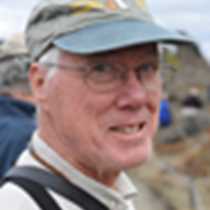King Haakon Bay, South Georgia Island
Ernest Shackleton left South Georgia Island on December 5, 1914 aboard his expedition ship Endurance, bound for his great Antarctic adventure, a crossing of the continent from the Weddell Sea to the Ross Sea, over the South Pole. He returned to South Georgia seventeen months later, on May 10, 1916, aboard one of his sunken ship's lifeboats, the James B. Caird, after an adventure of a very different sort. After the incredible small boat journey from Elephant Island, the Caird had been buffeted by a South Atlantic hurricane. The six occupants must have been miserable beyond description - tired, cold and sore, with their drinking water contaminated by seawater. They urgently needed a place to land. When the storm finally abated, they rounded Cape Rosa into King Haakon Bay, and found a narrow opening into a tiny cove, and there they found refuge.
Today we followed the path of Shackleton in King Haakon Bay in reverse order. In the afternoon, we boarded Zodiacs to cruise at Cape Rosa with a short landing in Cave Cove. Elegant light-mantled sooty albatrosses soared and called overhead. Shackleton's cave is a mere depression in the rock wall. We gazed at the spot where the men fell into exhausted sleep in that early winter night nearly 100 years ago.
Our morning landing - our first of this trip - took place deeper in King Haakon Bay at the spot Shackleton called Pegotty Bluff. Sir Ernest (he was knighted after his 1907-09 voyage to Antarctica on Nimrod) had a problem. He had reached the south coast of South Georgia, but all of the whaling stations that might offer refuge and a means to rescue his men waiting on Elephant Island were on the north coast. He made the audacious decision to walk across South Georgia with Tom Crean and the Skipper, Frank Worsley, while the other three waited at Pegotty Bluff. This morning the site was occupied by elephant seals. Females lay with their black pups, some newly born, others already doubled in size, weaned and independent. Huge, multi-ton males carried the wounds of recent battles for primacy on the breeding beaches. Now, they rested, watching for other males who might intrude into their hard-won territory. Giant petrels postured and squabbled over the carcass of a dead seal. A few king penguins stood together, changing their feathers before they return to the breeding colonies. Some of our group took a longer walk onto the foot of the glacier where Shackleton, Crean, and Worsley had faded from the view of those who waited. The three struggled on, over South Georgia, to reach the whaling station at Stromness; we returned to the warm comfort of the National Geographic Explorer.




